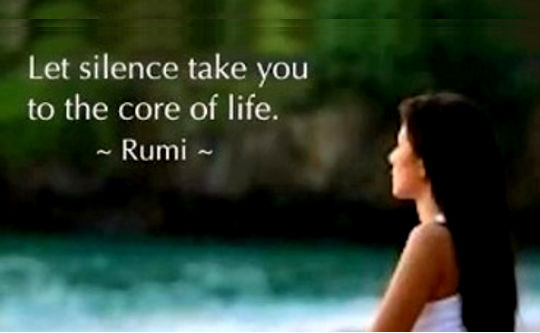
I am probably the last person that should be saying how, when, and where to meditate. I have set a goal of daily meditation at least a hundred times, and I haven't succeeded for more than three consecutive days.
It isn't a matter of not liking to meditate. I do, I really do. It is a matter of not taking the time to do it. I need to make it a priority in my life, and as of today, I haven't. So as you read what I think you should do, please take it with a grain of salt.
First of all, some things to avoid:
- Don't try to force something to occur. If you go into a trance and see Jesus, Buddha, and Elvis, that's fantastic. But don't go into your meditation expecting it.
- Don't over-evaluate the meditation. When it's over, enjoy the serenity and just be with it as it is. Analyzing takes away the feeling.
- Don't spend a lot of time trying to make your mind empty. You will experience a quieting of your mind, but it will happen spontaneously when you find the right meditation.
- Don't worry about "doing it right." Any attempt to listen to your heart is better than no attempt at all.
Now for the do's:
- Find a quiet place. No telephone, no television, no doorbell. If that means you have to take a pillow into the bathroom and lock the door, then do it. If the bathroom is a busy place at your home, I suggest you go to your local cemetery. Take a flower, sit by a grave, and don't make eye contact with anyone. I can almost guarantee you won't be bothered.
- Make sure you have gone to the bathroom and gotten a drink before you start. If you're hungry, have a snack.
- Get comfortable. Take off your shoes, loosen your clothing, relax. I cannot lay down without going to sleep, so I have to sit up. However, if you can stay awake, lying down is fine.
- Close your eyes and relax your body. Beginning at your feet and moving up to your head, tense and then relax every muscle group. Hold the tension and inhale, then relax as you exhale. Once you get the hang of this, you won't need to actually go through each step. A breath or two and you will automatically relax.
- Focus on your breathing. Breathe in through your nose, and out through your mouth. I am not sure why this works best, but it does. Make sure you take deep breaths, filling your lungs and stomach. Hold each breath as long as you can between the inhale and the exhale.
Okay, you're good to go. You can keep your eyes open if it works, or close them if it doesn't. I close mine and stare at the back of my eyelids. If I focus on that blackness, I can keep my thoughts at bay, which is what you want to eventually accomplish.
After many periods of watching that black wall, I was elated when it suddenly became three-dimensional. One minute I was looking at a flat surface, and the next minute I was in it. I felt like I could plunge into it, fly forever, and never touch physical matter. You will also see colors. Great splotches of iridescent colors, floating in from behind or approaching from in front of you. Just observe as you would a movie, and stay relaxed.
Don't make the mistake of assuming that your meditation is complete if and when you stop seeing colors. Your meditation is complete when you choose to stop. Twenty to thirty minutes is good, and you'll most likely start feeling antsy by then. Just bring your awareness back to where you are and end your meditation.
Meditation Techniques
There are numerous techniques for meditation. You might prefer listening to soothing music without vocals. There are tapes available that use a repeating tone (binaural beat) devised to shift your brain waves into specific states. Staring at a focal point and concentrating only on it can move some into a meditative state. It might be a blank space on a white wall, a pattern in a carpet, or a candle flame. Repeating a mantra (short phrase) either aloud or in your mind sometimes aids in reducing outside thoughts and noise.
There are guided meditations that can be purchased on tape, or you can make your own by recording one in your own voice. Guided meditations take you through a relaxation process and usually some other type of "scene" where you are working toward a goal of centering, stress reduction, weight loss, etc. Try different methods until you find what works.
Centering: Meditation in Action
Centering is meditation in action . . . staying in the calm. Being centered means not allowing your inner peace to be shattered by negative thoughts. When you are centered you are in a state of clarity and balance. A good centering technique will require only minimal concentration, permitting you to keep the majority of your attention on whatever else it is you are doing at the time. Here is an example of a very easy centering technique:
- Take several slow, deep breaths.
- With each in-breath, think or say "Breathe in calm."
- With each out-breath, think or say "Breathe out a smile." (It is nearly impossible to not smile when you do this.)
Meditating is a process that allows me to shake off the business of living in the physical. It erases the bills that are due tomorrow, the dishes that need to be washed, and the list on my desk. It brings me back to what matters, which is my center, which is love, which is what unites all of us. It reminds me of who I am.
When I meditate regularly, I am much more open to what is going on beyond what I can see, hear, or touch. It's like a light switch in a dark room. Once you find it and learn how and when to use it, things become much clearer.
Okay, Meditating 101: Sit. Relax. Breathe. Accept.
That's it. No expectations, no rules.
Do it regularly and you will never again be clueless as to what to do when feeling overwhelmed and anxious.
Reprinted with permission of the publisher,
Jodere Group, Inc. ©2001. www.jodere.com
Article Source
Love Never Dies: A Mother's Journey from Loss to Love
by Sandy Goodman.  One morning at 2:45 a.m., a phone call awakened Sandy Goodman -- her 18-year-old son, Jason had been electrocuted. That terrible night was the start of Sandy's journey through the black hole of unrelenting sorrow to the moment her heart began searching for answers. What she found over the course of years is that love knows no physical boundaries - that Love Never Dies.
One morning at 2:45 a.m., a phone call awakened Sandy Goodman -- her 18-year-old son, Jason had been electrocuted. That terrible night was the start of Sandy's journey through the black hole of unrelenting sorrow to the moment her heart began searching for answers. What she found over the course of years is that love knows no physical boundaries - that Love Never Dies.
Info/Order this book.
About the Author
 SANDY GOODMAN is the mother of three sons, including twins, Jason and Josh. Jason died of electrocution at the age of 18. His death started Sandy on a path of spiritual exploration through her grief. Sandy is now the founder, chapter leader and newsletter editor of the Wind River Chapter of The Compassionate Friends in central Wyoming.
SANDY GOODMAN is the mother of three sons, including twins, Jason and Josh. Jason died of electrocution at the age of 18. His death started Sandy on a path of spiritual exploration through her grief. Sandy is now the founder, chapter leader and newsletter editor of the Wind River Chapter of The Compassionate Friends in central Wyoming.



























